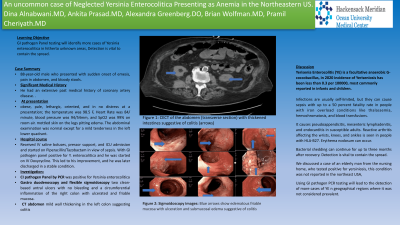Back


Poster Session B - Monday Morning
Category: Colon
B0130 - An Uncommon Case of Neglected Yersinia enterocolitica Presenting as Anemia in Northeast America
Monday, October 24, 2022
10:00 AM – 12:00 PM ET
Location: Crown Ballroom

Has Audio

Dina Alnabwani, MD
Ocean University Medical Center
Brick, New Jersey
Presenting Author(s)
Dina Alnabwani, MD1, Mehnoor Durrani, MD2, Ankita Prasad, MD1, Shashank Pandya, MD2, Alexandra Greenberg, DO2, Bassam Hasan, MD2
1Ocean University Medical Center, Brick, NJ; 2Ocean University Medical Center, Brick Township, NJ
Introduction: Yersinia is a facultative anaerobic gram-negative coccobacillus. Most infections are caused by eating and the contamination of food and water by infected animals. It causes fever, abdominal pain, which may mimic appendicitis, and bloody diarrhea, mostly in children due to cross-contamination of their feeds. Necrotizing enterocolitis can occur in infants. It is not commonly seen on the East coast of the United States for an older adult with no iron overload conditions.
Case Description/Methods: Our patient is an 88-year-old male with an extensive history of coronary artery disease presented with sudden onset of emesis, abdominal pain, and bloody stools. He had no chills or fever. At presentation, he was obese, pale, lethargic, oriented, and in no distress. His temperature was 98.5 F, Heart Rate was 84 beats per minute, blood pressure was 94/54mmHg, and SpO2 was 99% on room air. He had mottled skin on the legs with pitting edema. The abdominal examination was normal except for a mild tenderness in the left lower quadrant. The rest of the systemic review was normal. Computed Tomography (CT) abdomen showed mild wall thickening in the left colon, suggesting colitis. He received intravenous (IV) saline boluses and was then started on IV fluids, Zosyn, Unasyn, and Protonix. He needed pressor support and Intensive Care Unit admission for a brief time. Gastro duodenoscopy and flexible sigmoidoscopy showed two clean-based Antral ulcers with no bleeding and a circumferential inflammation of the right colon with ulcerated and friable mucosa. Gastrointestinal Pathogen Panel by PCR was positive for Yersinia enterocolitica, and he was started on IV Doxycycline. This led to his improvement, and he was eventually discharged in a stable condition.
Discussion: The centers for Disease Control and Prevention (CDC) monitors the frequency of Y. enterocolitica infections. In 2020 the incidence of yersiniosis was less than 0.30 per 100,000. Infections are usually self-limited, but they can cause sepsis with up to a 50% fatality rate in people with iron overload conditions like thalassemia, hemochromatosis, and blood transfusions. It causes pseudoappendicitis, mesenteric lymphadenitis, and endocarditis in susceptible adults. Reactive arthritis affecting the wrists, knees, and ankles is seen in people with HLA-B27. Erythema nodosum can occur. Bacterial shedding can continue for up to three months after recovery. Hence, its detection is vital to contain the spread.

Disclosures:
Dina Alnabwani, MD1, Mehnoor Durrani, MD2, Ankita Prasad, MD1, Shashank Pandya, MD2, Alexandra Greenberg, DO2, Bassam Hasan, MD2. B0130 - An Uncommon Case of Neglected Yersinia enterocolitica Presenting as Anemia in Northeast America, ACG 2022 Annual Scientific Meeting Abstracts. Charlotte, NC: American College of Gastroenterology.
1Ocean University Medical Center, Brick, NJ; 2Ocean University Medical Center, Brick Township, NJ
Introduction: Yersinia is a facultative anaerobic gram-negative coccobacillus. Most infections are caused by eating and the contamination of food and water by infected animals. It causes fever, abdominal pain, which may mimic appendicitis, and bloody diarrhea, mostly in children due to cross-contamination of their feeds. Necrotizing enterocolitis can occur in infants. It is not commonly seen on the East coast of the United States for an older adult with no iron overload conditions.
Case Description/Methods: Our patient is an 88-year-old male with an extensive history of coronary artery disease presented with sudden onset of emesis, abdominal pain, and bloody stools. He had no chills or fever. At presentation, he was obese, pale, lethargic, oriented, and in no distress. His temperature was 98.5 F, Heart Rate was 84 beats per minute, blood pressure was 94/54mmHg, and SpO2 was 99% on room air. He had mottled skin on the legs with pitting edema. The abdominal examination was normal except for a mild tenderness in the left lower quadrant. The rest of the systemic review was normal. Computed Tomography (CT) abdomen showed mild wall thickening in the left colon, suggesting colitis. He received intravenous (IV) saline boluses and was then started on IV fluids, Zosyn, Unasyn, and Protonix. He needed pressor support and Intensive Care Unit admission for a brief time. Gastro duodenoscopy and flexible sigmoidoscopy showed two clean-based Antral ulcers with no bleeding and a circumferential inflammation of the right colon with ulcerated and friable mucosa. Gastrointestinal Pathogen Panel by PCR was positive for Yersinia enterocolitica, and he was started on IV Doxycycline. This led to his improvement, and he was eventually discharged in a stable condition.
Discussion: The centers for Disease Control and Prevention (CDC) monitors the frequency of Y. enterocolitica infections. In 2020 the incidence of yersiniosis was less than 0.30 per 100,000. Infections are usually self-limited, but they can cause sepsis with up to a 50% fatality rate in people with iron overload conditions like thalassemia, hemochromatosis, and blood transfusions. It causes pseudoappendicitis, mesenteric lymphadenitis, and endocarditis in susceptible adults. Reactive arthritis affecting the wrists, knees, and ankles is seen in people with HLA-B27. Erythema nodosum can occur. Bacterial shedding can continue for up to three months after recovery. Hence, its detection is vital to contain the spread.

Figure: CT Abdomen showing mild wall thickening seen in the colon suggesting colitis.
Disclosures:
Dina Alnabwani indicated no relevant financial relationships.
Mehnoor Durrani indicated no relevant financial relationships.
Ankita Prasad indicated no relevant financial relationships.
Shashank Pandya indicated no relevant financial relationships.
Alexandra Greenberg indicated no relevant financial relationships.
Bassam Hasan indicated no relevant financial relationships.
Dina Alnabwani, MD1, Mehnoor Durrani, MD2, Ankita Prasad, MD1, Shashank Pandya, MD2, Alexandra Greenberg, DO2, Bassam Hasan, MD2. B0130 - An Uncommon Case of Neglected Yersinia enterocolitica Presenting as Anemia in Northeast America, ACG 2022 Annual Scientific Meeting Abstracts. Charlotte, NC: American College of Gastroenterology.
